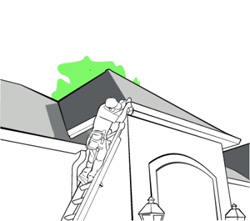
In Australia, we’ve all been brought up fearlessly climbing trees and fences, and jumping off the shed roof. As fond as those memories might be (and at the risk of sounding like we're too nervous about things), it’s important to understand how dangerous working at heights or climbing on your own roof can be if you don’t have the necessary equipment or training.
How dangerous is it? A fall from even a moderate height can easily cripple or kill you if you land the wrong way. All it takes is a wrong-footed step, a loose roof tile, a moment of vertigo or a surprise gust to throw you off your balance.
Roofs are designed to encourage things to fall off them - and human beings are definitely no exception.
To put the danger into perspective: special health and safety laws exist in Australia to ensure that all risks from potential falls are properly evaluated, and that any risk is properly dealt with. Even backyard decking in Australia requires sturdy handrails to prevent dangerous falls if the deck’s over 1m from the ground. Statistically speaking, there’s a significant risk of injury posed by an accidental fall from even just a metre.
How do tradespeople work at heights?
For a start, employers are required to assess any risks that might be involved with any work being done – and working at a height of more than two metres is automatically assumed to pose a serious risk. Anyone doing work at heights is required to have done special safety training for that exact purpose. This includes training on how to correctly use different types of ladders and safety gear, and what sorts of situations are likely to pose a greater danger to their health.
Nowadays most tradies won’t even go onto a roof if there aren’t fall prevention or fall arresting measures like roof anchors, harnesses and other required safety gear present. It’s not worth the risk, and they’re likely to run into all sorts of trouble making an insurance claim if they do get injured while not using the necessary safety gear.
Tradespeople who work at heights understand the risks very well, and are trained to deal with them.
Ladder safety
If you’re using a ladder (even just using a small step-ladder to change a light globe or reach the top-shelf biscuit tin), make sure you’ve read the manufacturer’s instructions and safety precautions.
Ladders are perfectly safe when they’re used properly, but are as dangerous as anything when they’re not set up correctly, used on slippery, loose or uneven ground, or are broken in any way. Even if you've had your ladder for years, take a quick look at the instructions.
Bravado and heights
Roof anchors, harnesses and ladder safety procedures aren’t just the result of 'nanny-state' coddling or fear of litigation – they save lives, and prevent countless horrific injuries. Think very carefully about what your health is worth before climbing up on your own roof to perform DIY maintenance.